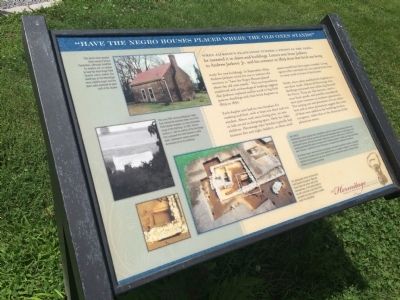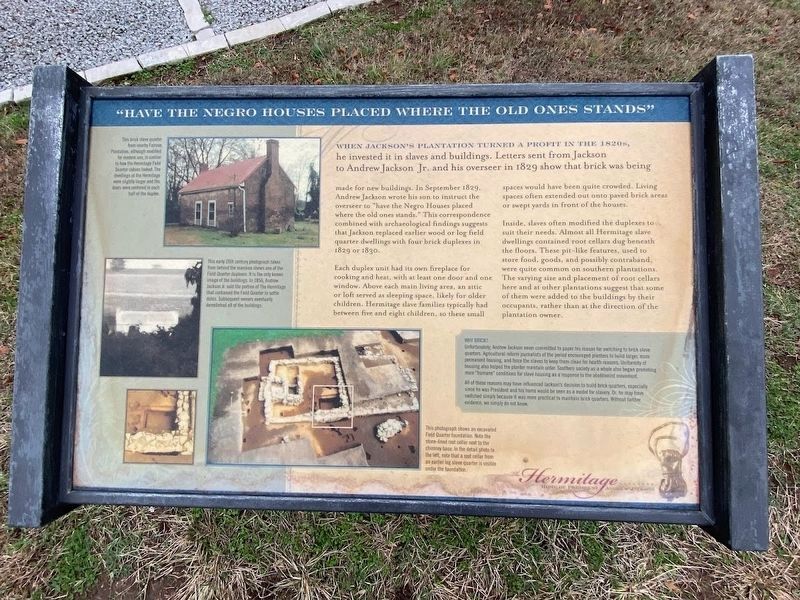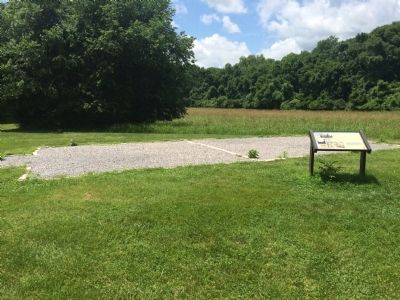Hermitage in Davidson County, Tennessee — The American South (East South Central)
"Have the Negro Houses Placed Where the Old Ones Stands"
Inscription.
When Jackson's plantation turned a profit in the 1820s, he invested it in slaves and buildings. Letters sent from Jackson to Andrew Jackson Jr. and his overseer in 1829 show that brick was being made for new buildings. In September 1829, Andrew Jackson wrote his son to instruct the overseer to “have the Negro Houses placed where the old ones stands.” This correspondence combined with archaeological findings suggests that Jackson replaced earlier wood or log field quarter dwellings with four brick duplexes in 1829 or 1830.
Each duplex unit had its own fireplace for cooking and heat, with at least one door and one window. Above each main living area, an attic or loft served as sleeping space, likely for older children. Hermitage slave families typically had between five and eight children, so these small spaces would have been quite crowded. Living spaces often extended out onto paved brick areas or swept yards in front of the houses.
Inside, slaves often modified the duplexes to suit their needs. Almost all Hermitage slave dwellings contained root cellars dug beneath the floors. These pit-like features, used to store food, goods, and possibly contraband, were quite common on southern plantations. The varying size and placement of root cellars here and at other plantations suggest that some of them were added to the buildings by their occupants, rather than at the direction of the plantation owner.
Why Brick?
Unfortunately, Andrew Jackson never committed to paper his reason for switching to brick slave quarters. Agricultural reform journalists of the period encouraged planters to build larger, more permanent housing, and force the slaves to keep them clean for health reasons. Uniformity of housing also helped the planter maintain order. Southern society as a whole also began promoting more “humane” conditions for slave housing as a response to the abolitionist movement.
All of these reasons may have influenced Jackson's decision to build brick quarters, especially since he was President and his home would be seen as a model for slavery. Or, he may have switched simply because it was more practical to maintain brick quarters. Without further evidence, we simply do not know.
Captions:
This brick slave quarter from nearby Fairvue Plantation, although modified for modern use, is similar to how the Hermitage Field Quarter cabins looked. The dwellings at the Hermitage were slightly larger and the doors were centered in each half of the duplex.
This early 20th century photograph taken behind the mansion shows one of the Field Quarter duplexes. It is the only known image of the buildings. In 1856, Andrew Jackson Jr. sold the portion
of The Hermitage that contained the Field Quarter to settle debts. Subsequent owners eventually demolished all of the buildings.
This photograph shows an excavated Field Quarter foundation. Note the stone-lined root cellar next to the chimney base. In the detail photo to the left, note that a root cellar from an earlier log slave quarter is visible under the foundation.
Erected by The Hermitage Foundation.
Topics and series. This historical marker is listed in these topic lists: African Americans • Anthropology & Archaeology. In addition, it is included in the Former U.S. Presidents: #07 Andrew Jackson series list. A significant historical month for this entry is September 1829.
Location. 36° 13.212′ N, 86° 36.714′ W. Marker is in Hermitage, Tennessee, in Davidson County. Marker is on Field Quarter Trail. The marker is along the Field Quarter Trail at The Hermitage. Touch for map. Marker is in this post office area: Hermitage TN 37076, United States of America. Touch for directions.
Other nearby markers. At least 8 other markers are within walking distance of this marker. A Lively Place (a few steps from this marker); The Field Quarter (a few steps from this marker); Stories Told by Things the Enslaved Left Behind (within shouting distance of this marker); The Field Quarter Spring (about 300 feet away, measured in a direct line); Land Conservation at The Hermitage
(about 400 feet away); Determined Resistance (about 600 feet away); The Hermitage Overseer (approx. 0.2 miles away); Ginning and Pressing "King Cotton" (approx. 0.2 miles away). Touch for a list and map of all markers in Hermitage.
Credits. This page was last revised on February 7, 2023. It was originally submitted on July 12, 2015, by J. Makali Bruton of Accra, Ghana. This page has been viewed 504 times since then and 25 times this year. Photos: 1. submitted on July 12, 2015, by J. Makali Bruton of Accra, Ghana. 2. submitted on January 23, 2023, by Darren Jefferson Clay of Duluth, Georgia. 3. submitted on July 12, 2015, by J. Makali Bruton of Accra, Ghana. • Andrew Ruppenstein was the editor who published this page.


